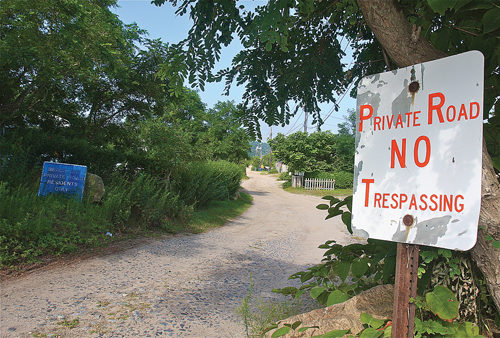Lawsuit takes aim at parking lots proposed, approved by, DEC

In a town awash with thousands of parking spaces, an application for another four might not seem like that big of a deal.
But tucked away on the far side of a private road in Baiting Hollow, abutting land the New York State Department of State has labeled “irreplaceable,” four parking spaces the state Department of Environmental Conservation permitted itself last year are creating quite a stir.
A group of Baiting Hollow homeowners have taken the DEC to court over the proposed spaces, claiming the state regulatory authority went out of bounds in granting itself a tidal wetlands permit for the spots “in secret — free from any public awareness and scrutiny,” according to court filings.
“If I wanted to build on that DEC piece of property, they would make me go through a full environmental review of the impacts,” said Frank Isler, the Riverhead attorney representing the Baiting Hollow Beach Association. “It’s surprising to us that they didn’t do that themselves. And our argument is that they can’t benefit from mishandling a procedure incorrectly.”
Last summer, the DEC filed for — and approved — four parking spaces in a .2-acre lot at the west end of Beach Way, a private road at the end of Edwards Avenue overlooking the Long Island Sound. The application calls for the removal of approximately 100 cubic yards of sand to be replaced with pervious material to facilitate car use. In addition, it proposes removing an existing gate on the site and installing guard rails along the perimeter of the parking area.
The .2-acre site abuts a larger, 81-acre parcel also owned by the DEC — land the agency says it wants to open to the public. In 2005, those lands, called the Baiting Hollow Wetlands and Beach, were added to a list of “significant coastal fish and wildlife habitats” by New York State’s Department of State.
“Any activity that would disturb or eliminate marsh, natural beach, and duneland plant communities would result in a loss of valuable wildlife species,” the designation states. The 81-acre property — one of about 250 such areas statewide — is considered “an important nesting site” for the endangered piping plover and the threatened least tern, according to the DOS.
But members of the Baiting Hollow Beach Association argue that the DEC’s application ignored that designation. And because the application was deemed to have a minor impact on the environment, notification otherwise required was not given, and neighbors were unaware of the permit until weeks after it was filed. One homeowner, Roger Schilling, said he heard about the permit in passing as he tried to obtain repair permits for his own property.
But by then, it was too late to challenge the DEC’s permit, as a 30-day window had already passed by the time homeowners filed suit.
“As soon as we heard about it, we brought [the legal challenge,]” Mr. Isler said.
Mr. Schilling said the project would require some “major dune bulldozing” to clear land for the parking spaces.
“Part of that dune is what saves the back row of houses [on Beach Way] from flooding,” he said. “That’s why this is one of the things that infuriates us, by calling it a minor project. It’s a major project.”








